
In high net worth groups and family wealth management circles, some people tend todeify“trusts“, as if by putting assets into an offshore trust, they can rest easy, completely isolate their debts, and avoid recourse.
InSeptember2025, this fantasy collapsed with a judgment of the High Court of Hong Kong, China, in the Xu Family Trust case: the order authorizing the liquidator to take over the assets of the Xu family, including those held in his offshore trusts,“blew through thefirewall“of the trusts, which had been“segregated by assets“.“.
This case has not only shaken China, but also created a storm in the global wealth management community. It reminds us that a trust is never a natural“island outside the law“and that its security is always based on the principles of legal structure and integrity.

I. What is a real trust?
In law,atrustis a property arrangement whereby asettlor/foundertransfers specific assets (trust property) to atrusteefor administration for the benefit of abeneficiaryor for a specific purpose, withrights and obligations specifiedin a trust deed (Trust Deed or other trust instrument).
The trustee has a fiduciarydutyto the trust propertyand must prioritize the interests of the beneficiaries, abide by the terms of the contract and operate legally.
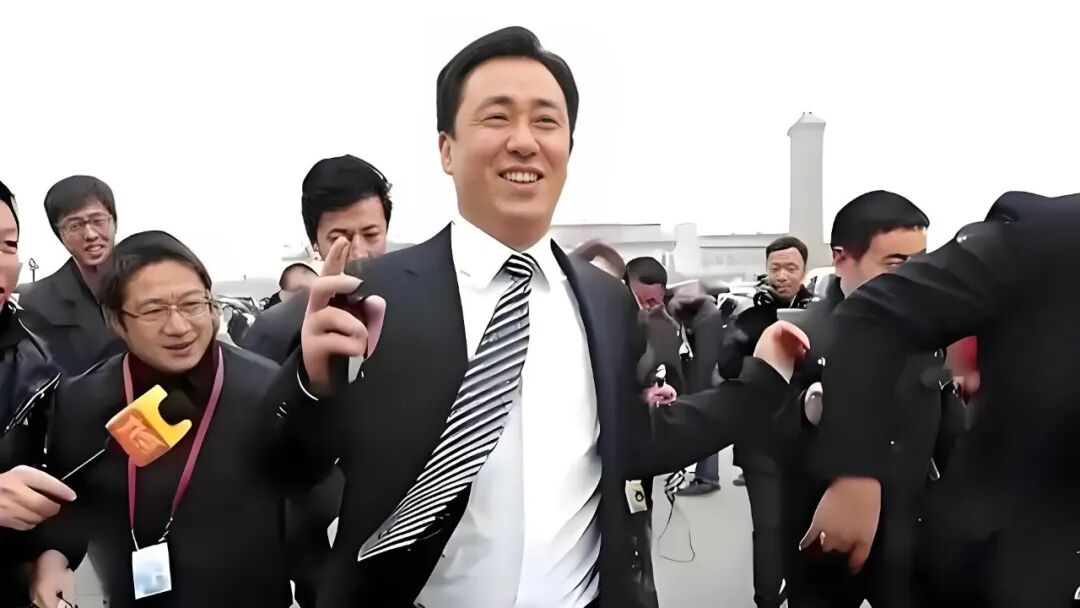
Photo/Hui Ka Yan, Source: Internet
1. Key features of the trust include:
Separation of Ownership of Assets:Legally, the trust property is in the name of the trustee, but its use and beneficiary rights are owned by the beneficiaries or limited by the terms of the trust.
Duty-bound:Trustees are not free to dispose of trust assets and are bound by covenants and held accountable for their actions.
Irrevocable/Alterable(depending on the nature of the trust): Some trusts arerevocable, but in many HNW family succession planning scenarios, they are often“irrevocabletrusts“to ensure that the assets are decoupled from the creator.
Clarity of purpose or beneficiaries:The principle of certainty (certainty of intent, certainty of property, certainty of beneficiaries) should be satisfied at the time of the creation of the trust,i.e., the purpose of the trust, the property and the beneficiaries must be clearly identifiable.
2. Under the ideal model,a true trust has the following foundational elements (i.e., the“bottom line“of the trust structure):
The principal must genuinelyrelinquish control:no right of revocation, no right to give unilateral instructions;
The trustee must beobjectively independentand not subject to direct manipulation by the trustee;
The source of the trust property must be legal and clear, and cannot be used to hide illegal gains or avoid debts;
The timing of creation should take into account the risk of liabilities: if assets are transferred when there is a known risk of liabilities, they can easily be challenged as fraudulent transfers.
3. The terms of the trust deed should be reasonable, transparent and reviewable by the court
It is only when these elements are met that a trust can truly function as a“segregation of assets” and “protection of liabilities“.If the trust is a nominal arrangement, with actual control retained by the settlor, the trust is likely to bea “nominal trust“, and the court may“pierce” the trust form and return to the substantive level.
It is worth emphasizing that a trust is not a panacea: it is not an“extra-legal safe deposit box“because of the complex risks involved in taxation, regulation, cross-border enforcement, claims recovery, and so on. The Xu Jiayin case is the most typical refutation of this myth.

Photo/Everest Group, Source: Internet

Secondly, the 3 major legal reasons for the breakdown of the HUI Trust in Hong Kong
Although many articles claim that“Hui’s trust has been struck down by Hong Kong“, strictly speaking, the Hong Kong court has not yet declared that layer of trust to be completely invalid in terms of entity. However, from the content of the judgment, the legal logic and the media’s public discourse, we can indeed summarizethe three major legal reasons whythe court“may strike through the trust“.
The following is summarized below:
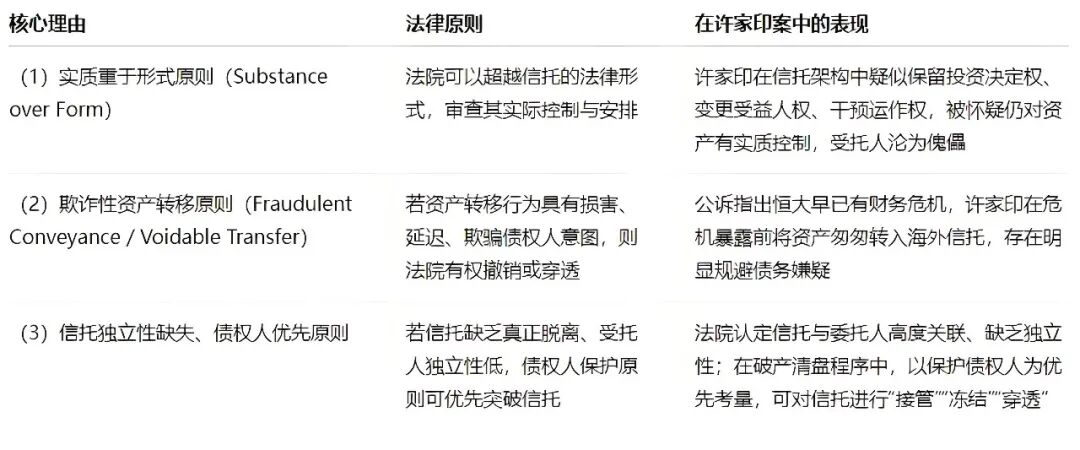
The following is an in-depth analysis of each.
1. The principle of substance over form: a look atcontrol behind“nominal“trusts
Under the common law system, although a trust has a tight formal structure, the courts are not focused on the form, but rather on the substantive control. If the settlor gives the assets to the trust, to the trustee, in form, but continues to control and dominate at the substantive level, then the court may find that it is ashamtrust oraself-benefittrust.
In the publicly available information, several lawyers and legal commentaries have pointed out that the trust structure is suspected to exist in the Hsu case in the following circumstances:
The principal retains core powers such as the right to make investment decisions, the right to replace assets and the right to change beneficiaries;
The trustee nominally manages the assets, but in reality is subject to the intervention and manipulation of the trustee;
The trust income distribution and asset arrangement reflects a high degree of family will control.
All of this has led to a disconnect between the form and the substance of the trust. In their decisions, Hong Kong judges have invoked similar common law principles, emphasizing that they“see through to substantive control“and“must not be misled by legal form“. According to media reports, the courts have used this as a basis for penetrating the structure of the trust and bringing the trust assets within the scope of receivership and freezing.
In the judgment, the court cited Edward Bartley Jones QC of the English High CourtinDadourian Group & Others v Azuri Ltd, emphasizing that even discretionary trustscan be subject to Chabra jurisdiction (i.e., the court’s jurisdiction to make a freezing order against a third party ) if they are substantially controlled by the defendant. (i.e. the court’s freezing order jurisdiction over third parties).
In other words, even if the trust arrangement is complex and off-shore, if it is in essence controlled by the principal, the court is likely to bypass the form and go straight to the substance. This is thefirst threshold of“trust breakdown“.
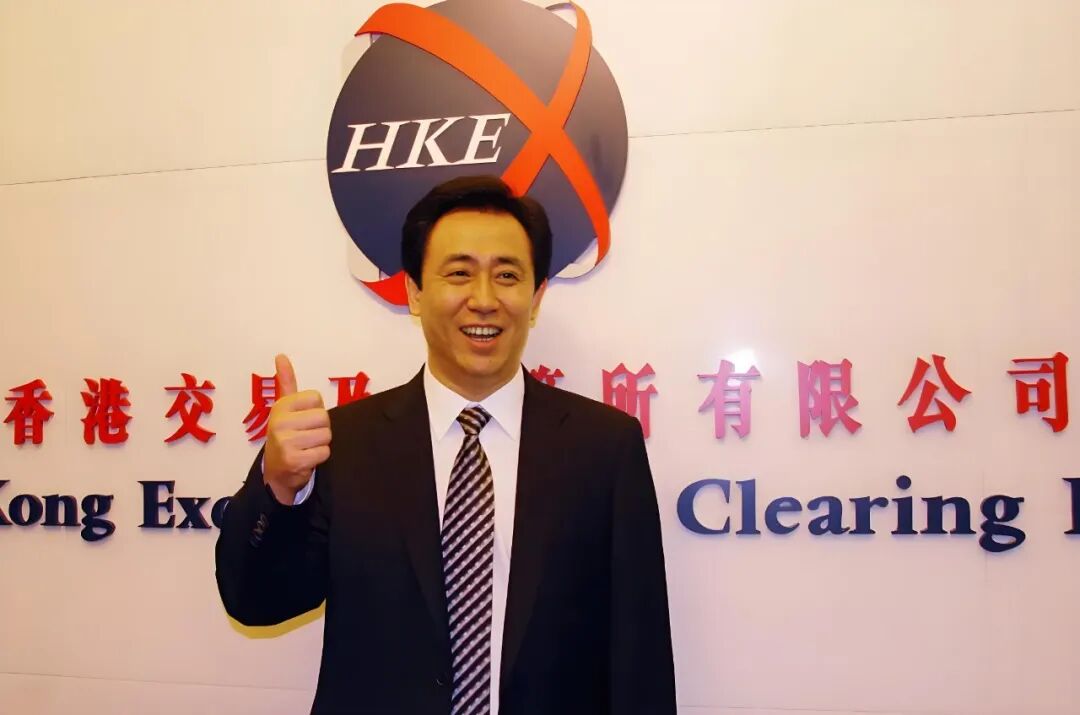
Photo/ Hui Kayan at Evergrande’s IPO meeting in Hong Kong, Nov. 5, 2009, Source: Philanthropist Magazine
2.Principle of fraudulent transfer of assets: unlawful disengagement is not affordable
Even if the trust structure is well designed, the injection of assets may be invalidated or avoided by the courtif it is inherently characterized as a fraudulent transfer. Both in common law jurisdictions and in Hong Kong’s insolvency law framework, there are legal mechanisms (e.g. the Bankruptcy Ordinance or bankruptcy avoidance provisions) that allow the court to retrospectively invalidate and set aside transfers of assets made in bad faith.
Disclosure of evidence submitted by the liquidator in the HUI case:
Evergrande Grouphas accumulated huge financial holes since 2017;
However, before the risks became apparent, Hui injected his personal assets into the trust through layers of offshore companies;
Xu should have been cognizant of Evergrande’s financial situation and the possibility of a break in its capital chain when the trust was established;
This sudden transfer of assets on the eve of a debt or financial crisis is highly typical of fraudulent transfers.
In its decision, the court emphasized that“a debtor cannot default on a large debt and at the same time use a trust to retain a large amount of wealth for himself and his family“. It was thus held that the transfer of assets should not be protected by the trust system if it was done with the purpose of avoiding the debt and fraudulently defrauding the debtor.
This is one of the trust killers: even if the form of the trust is well organized, as long as the source and purpose of the funds are suspected to be debt avoidance, the trust itself may become a revocable arrangement.
3. Lack of fiduciary independence and the principle of priority of creditor protection: a break in the institutional logic
A third logical underpinning is that if a trust’s independence is absent, its“segregation“function will be lost; furthermore, in insolvency winding-up proceedings, courts are often willing to“take over” or “ freeze “ or pass-through orders to trusts on the basis of the public policy of giving priority to the protection of creditors. “Freezing“or piercing orders.
The asset segregation function of a trust is based on thepremise that the trusteeand the principal are truly“decoupled“, i.e., the trustee manages independently and is not controlled by the principal. However, in the Hui case, the court found that the trustee and the principal were highly interrelated and the control was not truly divided. This essentially negated the isolation function of the trust.
Subsequently, the court further held that the protection of creditors’ interests is apublic policy priorityin the context of debt crises and insolvent liquidation, and that the court could break out of the trust structure and take possession of the trust, freeze it or return it if necessary.
In Hong Kong law, the Recognition of TrustsOrdinance(Cap. 76) is the basis for recognizing the validity of trusts, but the Ordinance also makes it clear that the assets of the trust shall not form part of the property of the trustee in the event of his insolvency or bankruptcy. In other words, when the trustee becomes insolvent, its debtors cannot claim the trust property.
In addition, the Hong Kong courts have grantedprocedural tools such asreceivership / managerial takeover,freezing / Mareva injunctionand disclosure ordersbased on common law principles and insolvency law tosecure legitimate recourse for creditors. In its decision, the court clarified that the receiver’s authorized functions of identifying, investigating, and preserving assets do not immediately change the ownership of the assets, but are procedural tools; however, if it is subsequently proven that the trust arrangement is invalid or voidable, then the trust assets may be substantively“struck through“.
It is worth noting that the judgment does not explicitly assert that a particular layer of the trust has been physically“broken”.Much of the talkin the media about“trust breakdown“comes from the court authorizing the liquidator to take over a wide range of assets and freezing the trust level, but this is legally more of a procedural preservation than a revocation of the trust deed itself. Nevertheless, this has been a very strong blow to trust arrangements.
In a nutshell, these are the top 3 reasons:
The Hong Kong side pointed out that although Xu Jiayin nominally transferred the assets into the trust, but retained the core control of investment decision-making, replacement of beneficiaries, the trustee was reduced to a “puppet”. More critical is that Evergrande buried financial black hole as early as 2017, Xu Jiayin knows that the company is in crisis, still in 2019 before the outbreak of the crisis sudden transfer of assets, which obviously belongs to the “fraudulent transfer of assets”.
The Hong Kong court “struck down” the Hui family trust on the basis of the “substance over form principle” and the “fraudulent transfer of assets principle”.
First, “substance over form”, no matter how complex the trust structure, as long as the trustee can actually control the assets, it is not really independent of the trust; second is the “anti-fraud principle”, the debtor can not be owed a large amount of debt, while using the trust to retain wealth for his family; finally, “creditor protection priority”, the law is more inclined to protect the rights of ordinary creditors who are owed wages and house payments in a large-scale debt crisis. Finally, there is the “creditor protection priority”, in a large-scale debt crisis, the law is more inclined to protect the rights and interests of ordinary creditors who are owed wages and house payments. These three pillars of jurisprudence, so that Xu Jiayin’s family trust line of defense was “pierced”.

Picture: Mr. and Mrs. Hui Ka Yan and Ding Yumei, Source: Internet

III. Singaporevs.Hong Kong:
Comparison of the advantages of trust systems and the choice of family trust layout
In the eyes of many, Hong Kong and Singapore are the two major wealth management centers in Asia, and the comparison of trust systems has attracted much attention. Especially in the eyes of mainland HNWIs, choosing HongKong/Singapore trusts is oftenpart of a“wealth haven“strategy.
By comparing the systems and practices of the two places, the following points are particularly noteworthy.
1. Outstanding advantages of the Singapore trust system
The following are some of the often highlighted strengths of Singapore in the trust sector and the basis of its ability to become a trust hub in Asia:
The advantages and concrete manifestations and legal basis are as follows:
(i) High level of confidentiality:Singapore trusts do not have a public trust register, and trust deeds and beneficiary information are generally not disclosed to the public. If the trustee is a licensed trust company, it is legally obliged to maintain confidentiality and may be held liable for disclosure of information.
② Tax incentives:Singapore usually does not levy income tax on non-Singapore sources of investment income; trust property transactions and distributions can also enjoy capital gains tax exemption, no inheritance tax, no gift tax and other concessions.
(iii) Sound legislative and regulatory framework:Trusts areregulatedby the TrustsAct, TrustCompanies Actand other laws, and licensed trust companies are required to be registered and regulated by the Monetary Authority of Singapore (MAS).
Flexibility and customizability of the contract:the principal can set theprotector, distribution rules, trust period, reinvestment terms, etc., which has a high degree of plasticity.
⑤ Legal predictability and stability:The Singapore legal system has inherited the English trust law tradition, with a mature judicial system, abundant case law and robust interpretation by judges, which can provide predictable support for family trust arrangements.
(vi) Succession rules barrier:Singapore trusts are not subject tothe rules ofthe law of forcedheirship.Section 90(2) of the Trustee Actmakes it clear that the rules relating to succession shall not affect the validity of a trust if it is entitled to be created under the applicable law.
In actual operation, Singapore trusts are also often used for asset segregation, wealth inheritance, tax optimization, family governance and other purposes. Its institutional design enables high net worth families to have a stronger ability to cope with cross-border assets, multi-generational inheritance and regulatory changes.
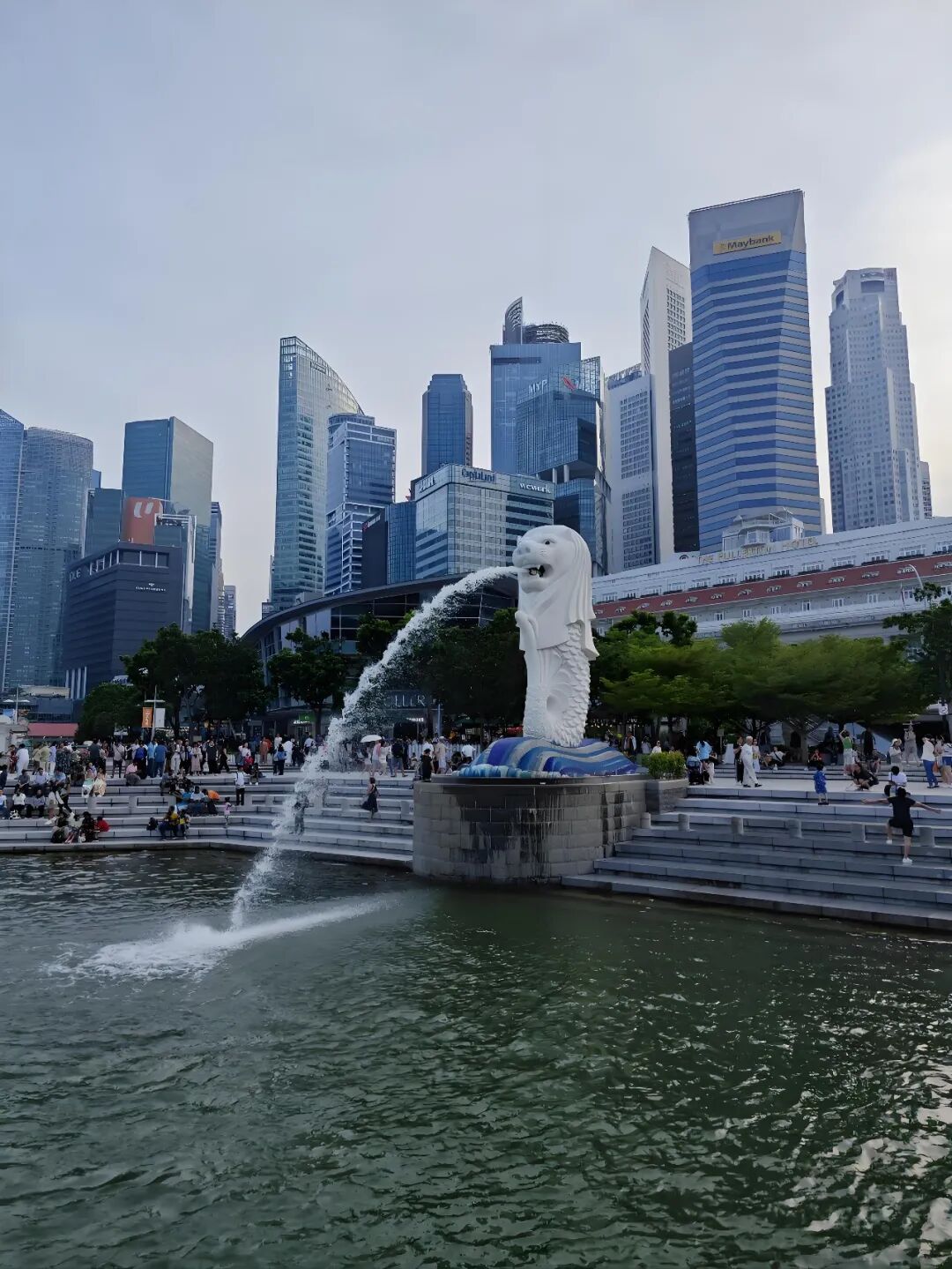
Photo/Singapore, Source: Internet
2. Characteristics and limitations of the trust system in Hong Kong, China
Although Hong Kong, China, also has a trust system foundation, its advantages and limitations are more obvious in comparison:
① Characteristics and advantages:
Hong Kong recognizes fiduciary relationships and the Recognition of Trusts Ordinance (Cap. 76) incorporates the Hague Convention on the Recognition of Trusts into the Hong Kong regime.
With a mature judicial system, strong enforcement and international harmonization, Hong Kong courts have rich experience and authority in cross-border asset freezing and winding-up receivership. The HUI case demonstrates the ability of Hong Kong courts to review and enforce fiduciary relationships in insolvency proceedings.
The proximity to mainland China and the obvious advantages of language, culture and market convergence make it more convenient for mainland HNWIs to set up trust layouts.
② Limitations and Risks:
The jurisprudential risk of trust defenses being penetrated is high:
As the Hui case shows, Hong Kong courts have a strong willingness and ability to break through the trust structure when the trust arrangement is suspected of being used for debt avoidance and substantial retention of control.
Tax system disadvantages:
Hong Kong trusts are not designed with significant tax incentives and may face tax constraints on portions of trust income and capital gains. Compared with Singapore’s tax-free regime, Hong Kong’s tax incentives are insufficient.
Public policy bias and the creditor preference principle:
Trust arrangements are vulnerable to challenge in insolvency winding-up proceedings, where courts often stand to protect creditors by conducting preservation, receivership or penetration reviews of trusts.
Trust transparency and disclosure pressures:
In the event of major litigation, disclosure orders, freezing orders, etc., the court has the authority to require disclosure of the trust structure, assets, documents, etc., and it is more difficult to obtain a complete guarantee of trust privacy protection and confidentiality.
The trust law regime is relatively weak:
Although Hong Kong law recognizes trusts, its own trust law system is not as solid as that of Singapore; there is a lack of sound legislation on innovation in the trust law system, trust regulation and trustee supervision.
Therefore, for HNWIs who use trusts as a wealth segregation and debt protection tool, Hong Kong trusts may not be the safest option in the face of extreme risk events.

Figure/Hong Kong, China, Source: Internet
3. Comparison and summary:Several key points ofSingapore’s victory overHong Kong:
From the above comparison of advantages and disadvantages, several key judgments can be drawn as follows:
Confidentiality and privacy:Singapore has the advantage that trust arrangements are less susceptible to prying eyes.
② Tax efficiency:Singapore is more favorable in terms of non-local income, capital gains, inheritance tax, gift tax, etc.
(iii) Institutional predictability and legal support:Singapore is more stable in terms of trust law institutional sophistication and jurisprudential accumulation.
④ Resilience to insolvency claims:Although there is no system of full insurance, Singapore trusts are properly designed in terms of transfer of assets, time of establishment, division of control, etc., which reduces the risk of being penetrated.
⑤ Geographical and market integration:Hong Kong has an advantage in terms of proximity to the Chinese market, convenience, language and cultural proximity.
Therefore, when it comes to the layout of family trusts, many professional law firms and wealth management organizations prefer to recommend Singapore as the core of the trust structure, supplemented by other offshore jurisdictions (e.g. Cayman,BVI, UK, etc.).
However, it is important to emphasize: even in Singapore, trusts are not untouchable and may be subject to court or cross-border recourse challenges if the trust arrangement is not properly designed, too much control is retained, the timing of establishment is not compliant, and the source of assets is in doubt.

IV. Strategic Recommendations on the Layout of High Net Worth Individuals and Family Trusts
Taking the Hui Ka Yan case as a mirror, for families and individuals who truly wish to protect their assets and pass on their wealth through trusts, the following strategies and principles deserve attention:
1, legal and compliance is always the bottom line
Legitimate source of assets:The assets injected by the trust must be legal and clear to avoid the risk of suspected illegal income, tax evasion and money laundering;
Avoid transfers when there is a clear debt crisis: if a trust is created at a time when there is a known or foreseeable risk of debt, it is highly susceptible to a court finding of fraudulent transfer;
Avoid excessive retention of control: principals should relinquish core control rights (revocation rights, investment instruction rights, asset replacement rights, etc.) wherever possible;
Compliance disclosure and cooperation with the judiciary: in the face of court disclosure orders, freezing orders, etc., actively cooperating with court investigations and disclosure of trust documents is conducive to securing trust protection.
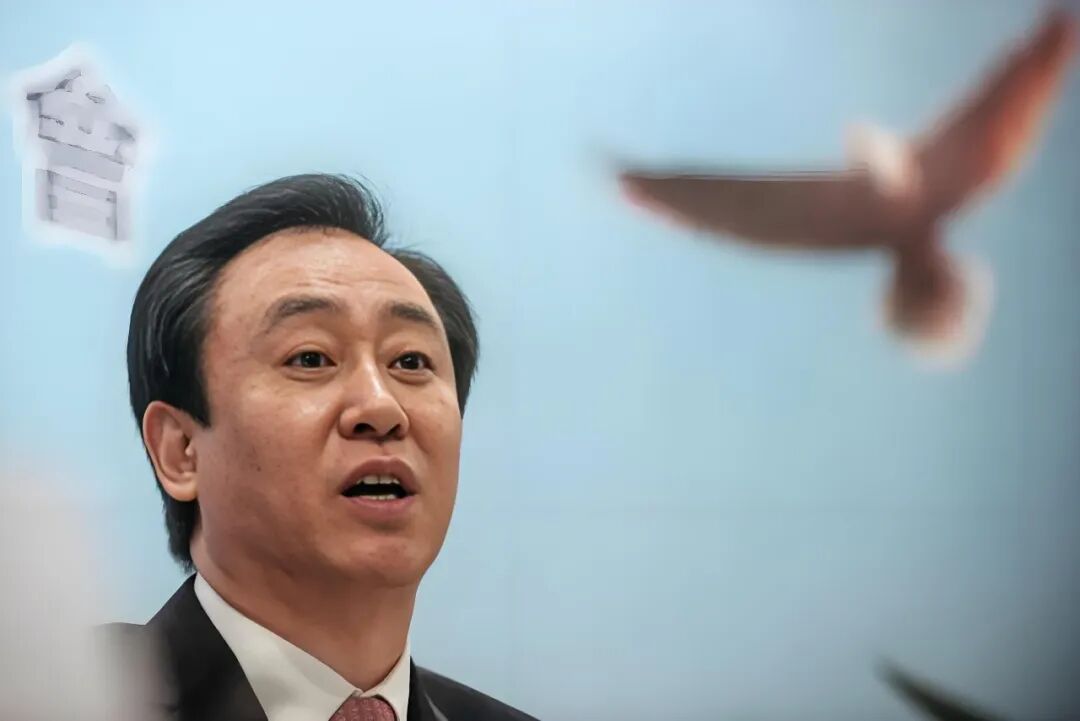
Photo/Hui Ka Yan attends China Evergrande’s 2016 results presentation on March 28, 2017 in Hong Kong. Source: philanthropist magazine
2. Structural design is designed to be“wearable“rather than“impenetrable“.
The ideaof designing a trust so that it cannot be“pierced“by a courtis unrealistic; the point is that it is extremely costly and difficult to make it so. Specific considerations may be made:
Multi-layer trust structure design (e.g., parent trust+sub-trust);
Separation of fiduciary and investment management, independent professional fiduciary;
The Protector mechanism (Protector) controls the change of beneficiaries, trustee turnover authority to check and balance;
Contingent Trustarrangementsare in placeto deal with judicial risks;
Set up parallel trusts in different jurisdictions (but be aware of the risk of cross-district conflicts).
3, timing and layout to curve rather than a one-time sprint
Laying out in advance and shifting gradually, rather than massively on the eve of a crisis;
Multi-jurisdictional diversification of risk and not putting“all your eggs in one basket“;
Balancing liquidity and preservation should not tie up the entire asset for the sake of preservation.
4. Risk assessment and dynamic monitoring
Regularly review trust structure and operational compliance and assess legal, tax, and regulatory risks;
Regularly review changes in the domestic and international judicial environment, such as litigation assistance, insolvency treaties, resource-sharing mechanisms, etc;
Setting up fiduciary insurance, legal protection mechanisms (e.g. dispute resolution clauses, arbitration clauses, insurance solutions, etc.).

Photo/Evergrande Real Estate, Source: Internet
Conclusion: Trust is a“tool“, nota “shield“.
Perhaps the biggest lesson from the HUI case is that a trust is not an all-purpose safe, let alone an umbrella for debt violators. As rumors circulate, the “trust breakdown“statement, there are exaggerated elements, but the judicial logic behind it and the impact of the system is real.
The willingness and ability of the Hong Kong, China, courts in this case hasshattered the long-heldillusion of the “absolute safety of offshore trusts“.
A truly effective trust must be based on legality, transparency, trustee independence, reasonable division of control, and compliance with the timing of its creation. If one of these elements fails, a court may challenge the trust structure.
After Hong Kong has been struck through the trust, many will look to Singapore. The Singapore trust regime has obvious advantages in terms of confidentiality, tax benefits and predictability of the legal system, but it is by no means an impossible fortress to cross. Regardless of where you choose to center your trust structure, the design philosophy should be to“raise the cost of defense, maintain flexibility, and be legally compliant rather than exploiting loopholes“.
Finally, the value of trusts cannot be completely denied by a single judicial case, but the Xu Jiayin case has undoubtedly served as a cautionary tale: against the backdrop of a tightening global judiciary and an ever-improving cross-border recovery mechanism, the protection and inheritance of wealth is no longer a technical issue, but rather an issue of the rule of law, the system and the value of the issue.
Whenthe “trust“is put under the light, the more subtle the design, the more likely to be scrutinized; only legal business, integrity-based, careful layout, prudent operation, in order to preserve the foundation in turbulent times.
If you have such a need, please contact your Relationship Manager and we can provide you with further guidance on“How to design an anti-penetration structure if you are setting up a family trust in Singapore“or“Comparison of specific trust laws/jurisprudence“. Take action now!
Note:References from Phoenix Financial Services, First Financial Services, Philanthropist Magazine, comprehensive news reports collated, reprinted with attribution, erosion and deletion contact.
…
👇 Plus V enters Singapore’s largest outbound community 👇

Past Recommendations

